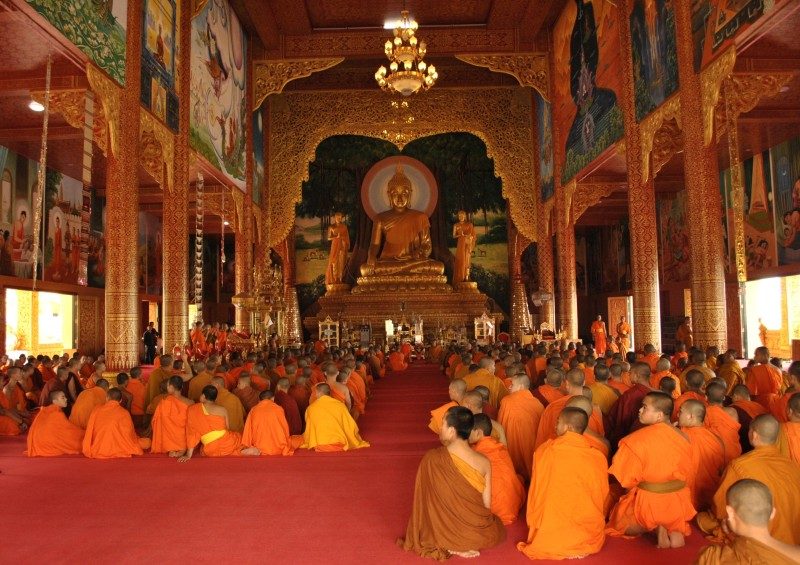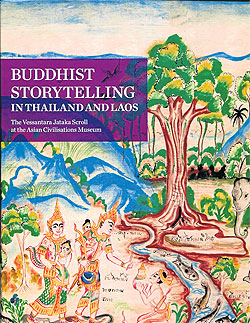Leedom Lefferts and Sandra Cate, with Wajuppa Tossa, Buddhist Storytelling in Thailand and Laos: The Vessantara Jataka Scroll at the Asian Civilisations Museum
Singapore: Asian Civilisations Museum, 2012. Pp. xvi, 163; map, figures, glossary, bibliography, index.
Reviewed by Arthid Sheravanichkul.
The Vessantara Jataka ceremony, generally known as thet mahachat, flourishes in all regions of Thailand. However, the ceremony varies widely by region and society in the pattern of its presentation, the period of the year in which it takes place, and its significance and meaning.
Among Thai-Lao people in Northeast Thailand or Isan, thet mahachat is called bun phawet or bun phra wet. As a part of the hit sip song,the twelve annual rituals, bun phra wet is traditionally arranged in the third, the fourth or the fifth lunar month, and the Vessantara Jataka scroll or pha yao phra wet figures significantly in the ceremony, which is unique in Thai Isan and Lao culture. On the first day of the ritual, before the recitation a procession of villagers carries the pha yao phra wet from outside the village back into the village in order to imitate the return of Prince Vessantara to the city. Then the scroll is hung around the sala or the place where the recitation is to take place.
Buddhist Storytelling in Thailand and Laos focuses mainly on the Vessantara Jataka scroll or pha yao phra wet painted by Sopha Pangchat (1909-1966) kept at the Asian Civilisations Museum in Singapore. The book gives a well-rounded view of this Vessantara Jataka scroll by treating its physical appearance, material, style and background philosophy and by positioning the scroll in the Northeast Thai and Lao socio-cultural and socio-economic contexts. Through their treatment of this scroll, the authors portray the importance of such scrolls in bun phra wet ceremonies in Northeast Thailand and Laos more generally. They also succeed in illustrating the significance of the bun phra wet ceremony in this Buddhist regional culture. The book shows clearly that the ceremony plays dynamic roles in the society, both as a religious practice and as a social activity–roles that relate to people’s mentality, to religious devotion, to supernatural power, to state power, to Buddhist reform and to politics and the economy.
The book is divided into five chapters. The purpose of the first chapter is to show the whole scroll and to tell the story as it unfolds in each of its panels. It thus makes the reader feel that he or she is “listening” and learning about the story from a narrator while looking at the pictures–scene by scene, episode by episode. This seems to imitate the traditional way of looking at scrolls or religious paintings and learning stories from them.
The second chapter, “Scroll, festivals, performances”, demonstrates the use of the scroll in the thet mahachat ceremony, the belief in merit that supports the making and offering of the scroll, and the bun phra wet itself. The authors offer manyinteresting remarks on the scroll and the ceremony. They argue, for example, that the procession preceding the ceremony mentioned above represents the transformation of the spaces of the village into a “city”, while the scroll painter and the villagers become the “narrator”, as the whole story depicted on the scroll is told through the interpretation of the painter. And when the scroll is carried by the villagers in the procession to invite Prince Vessantara from the “forest” into the “city”, they become “characters” in the story. In performing the ritual, the villagers bring the narrative world into the real world and substantiate Prince Vessantara’s ideal of generosity in their real life. The return of Prince Vessantara is celebrated not only as a great triumph after the gifts that he made of his children and wife. It is also a celebration of the promise of the great rain of prosperity, so important to Thai-Lao agricultural society.
Another interesting point is the authors’ contextualisation of the bun phra wet in the process of social change and “modernisation” since the reign of King Chulalongkorn (1868-1910). The reform of Thai Buddhist ideology and the centralisation of monastic education in the late nineteenth and early twentieth centuries had a strong influence on the traditional ceremony. So, too, did the social changes that occurred as Thailand became a more industrial society in the mid-twentieth century. Tradition has declined or changed in importance and meaning in some areas.
The third chapter is entitled “Artists tell the story”. It is about the tradition and convention of making scroll paintings of the Vessantara Jataka in Northeast Thailand and Laosand about the ways in which different artists, as storytellers, interpret or tell the same story. We learn about the essential motifs that must be depicted on the scroll and the creative interpretation of the setting and of the actions of the characters. Also, the authors mention changes of material and style and note that the scroll has become more like a “mass product” (page 70). This discussion of material and style yields understanding of the production of scrolls, as the core objects of the ceremony, and its development over time.
The fourth chapter of Buddhist Storytelling in Thailand and Laos, on “The writing on the scroll”, shows the Central Thai and English translations of all the writings on Sopha Pangchat’s scroll. These translations, prepared by Wajuppa Tossa, include the dedication, information on the artist, captions, and the characters’ dialogues. The writing on the scroll is in Thai, Lao, and Khmer scripts. The translator also provides some notes on the objects shown on the scroll, cultural terms, metaphors or symbols that may need to be explained to some readers. This translation reflects the attempt in the book to allow readers to understand and see the value of this scroll as much as possible.
The last chapter is “Notes on the artist and the scroll in Singapore”. It gives information on Sopha Pangchat as a great scroll artist, on Wat Ban Tha Pho Sri–the temple in Ubonratchathani Province where the scroll was originally offered–and on the physical condition of this scroll.
The book provides a useful glossary of terms concerning the characters in the Vessantara Jataka and the bun phra wet ceremony. However, some translations of Thai words in the chapters may not be accurate. For example soi dao (page 49)literally means “gathering the stars” rather than “helping the stars”. And the word rajawat (page 49)–derived from the Sanskrit word r─Бjavati–refers to the fences marking a ceremonial space rather than to “royal temple”.
General knowledge on the Vessantara Jataka ceremony comes above all from the Central Thai tradition. With their experience, however, the authors of Buddhist Storytelling in Thailand and Laos expand our understanding of the ceremony and of the ritual objects unique to the Northeastern Thai and Lao tradition through the study of Sopha Pangchat’s scroll painting. The book shows not only the importance of the scroll in the ceremony but also the importance of this ceremony in Thai-Lao culture both in traditional and contemporary societies.
This book, therefore, makes a great contribution to the study of the bun phra wet. The Vessantara Jataka ceremony has changed in all regions of Thailand. In the Northeastern province of Roi Et province, for example, the bun phra wet has been changed from a religious and social activity undertaken by the community into an “official” provincial tradition with a new meaning in the new context, especially in the use of the ceremony in the making of “identity” and thus in tourism. Still, the pha yao phra wet remains one of the most important motifs in the ceremony. The scroll plays a significant role not only in the ceremony itself but also in any consideration of this ritual in the modern context. It is a witness to the transformation of this ceremony from the past to the present.
Arthid Sheravanichkul is a lecturer in the Department of Thai and the Thai Studies Center, Faculty of Arts, Chulalongkorn University, Bangkok.
 Facebook
Facebook  Twitter
Twitter  Soundcloud
Soundcloud  Youtube
Youtube  Rss
Rss 
